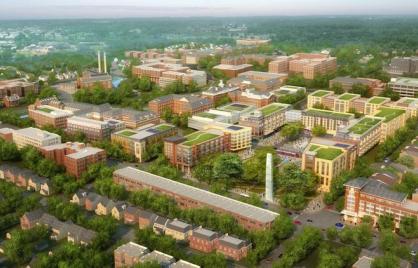
Washington Business Journal by Michael Neibauer
The District has reached an agreement with the U.S. Army and the master development team for the acquisition and lease of the former Walter Reed Army Medical Center campus, setting the stage for work to begin on the 3.1 million-square-foot mixed-use project.
Under a pair of deals submitted by Mayor Muriel Bowser's administration to the D.C. Council for its review, the city has agreed to pay the Army $22.5 million for 66.27 acres of the sprawling 110-acre Walter Reed complex. The District’s portion — most of the remaining land is being turned over to the State Department — is bounded by Fern Street, Alaska Avenue, 16th Street, Aspen Street, and Georgia Avenue NW.
At roughly the same time it closes with the Army, the District will enter into a long-term lease with the master development team — a joint venture of Hines Interests LP, Urban Atlantic and Triden — and work on the two decade-plus project will begin. D.C. will collect $25 million over eight years under the lease with the development group, offsetting what's owed to the Army.
The Walter Reed hospital was a victim of the Pentagon's Base Realignment and Closure, or BRAC, process. It was shuttered in August 2011 and moved to a new operation in Bethesda. Beginning in 2006, the District started planning for Walter Reed's future, entered into negotiations for its acquisition, and launched a search for a master developer. In November 2013, then MayorVincent Gray selected the Hines-Urban Atlantic team over several, equally well-known competitors.
The Parks at Walter Reed, as currently envisioned, will contain 3.1 million square feet — 2,100 residential units (432 affordable), two charter schools, a town center with a large-format grocery store, 185,000 square feet of office space, a non-emergency ambulatory care clinic from Howard University, homes for homeless veterans and seniors, and 14 acres of open space. It will include a commercial area focused on bioscience and health, a hotel/conference center carved out of the historic Walter Reed hospital, and arts space for groups such as Cultural D.C., Artomatic and the Washington Dance School.
Walter Reed's "Great Lawn" will also be reintroduced for public use.
A new Engine Co. 22 fire station will service Walter Reed. Mayor Muriel Bowser is scheduled to break ground on that project, the first at Walter Reed, on Wednesday.
The overall project is expected to create 2,300 construction jobs ($125.2 million in construction wages), 3,460 jobs at buildout, 1,890 new households and 3,990 new residents. The District anticipates more than $30 million in new annual revenue from the redeveloped Walter Reed, though that will be partly offset by the $15 million-plus annual cost of serving the campus.
Walter Reed is currently home to 25 major structures totaling 3.6 million square feet — 72 percent of which is contained within Building 2, the former main hospital building. All but 10 of the buildings will be demolished and replaced with 26 new structures, from townhouses to multistory mixed-use buildings. The remainder, a collection of historic buildings, will be retained and reused.
Unlike St. Elizabeths East and the McMillan Sand Filtration Plant — where the District will pay more than $150 million to ready those two sites for vertical development — the master development team will shoulder the cost of the horizontal site work at Walter Reed. Here are some estimates for the job to come:
- $8.2 million to build 10,500 linear feet of roadway
- $4.6 million to replace the sanitary sewer system
- $12.2 million to replace the water distribution system
- $21.2 million to meet stormwater standards
- $6.7 million to replace and relocate the electrical and telecom system
- $500,000 to remove two 400,000-gallon fuel oil tanks
The first phase of the project will be the demolition of the main hospital building, followed by the opening of the first open space and the Great Lawn, all within the first two years. Vertical construction on the initial residential will begin within three years. The project is expected to be complete by 2038.


